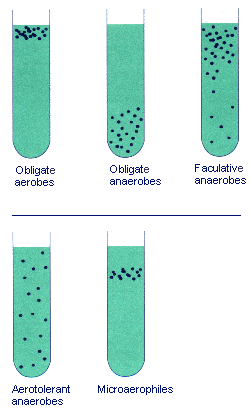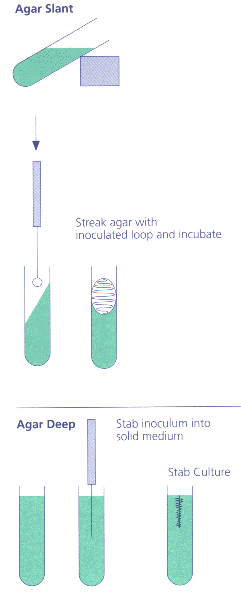| Bacillus alcalophilus | |||||
|
| |||||
| Osmotic pressure | halophile | 0.5 | 1-2 | 4-4.5 | Vibrio costicola |
| (Molar salt conc) | extreme halophile | 3 | 3 5 | 5.2 | Halobacterium halobium |
|
| |||||
Oxygen

Microbes that use oxygen for energy-yielding purposes are called aerobes, if they require oxygen for their metabolism they are called obligate aerobes. Obligate aerobes are at a disadvantage because oxygen is poorly soluble in water and much of the environment is lacking in this necessary element. Often, aerobic bacteria have retained the ability to grow without oxygen; these are called facultative anaerobes. Those bacteria that are unable to use oxygen and in fact may be harmed by it are known as obligate anaerobes. Further groups include: the microaerophiles which are aerobic microbes that tolerate only a narrow band of oxygen concentrations usually lower than that of the atmosphere and are therefore often difficult to cultivate in the laboratory, and aerotolerant bacteria that grow in the presence of oxygen but do not require it. In contrast to higher organisms, the metabolism of microorgansims is dependent on the presence of liquid water. The requirements of microorganisms with respect to available water differ widely. In order to compare the available water content of solids and solutions, water activity or relative humidity are useful parameters. Carbon Dioxide
In autotrophic metabolisms, microbes tap various sources of energy and reducing power, which they use to reduce CO2 to organic compounds. Sodium hydrogencarbonate is usually added to the culture media if autotrophic CO2-fixing microorganisms are to be grown, and incubation is performed in a carbon dioxide-containing atmosphere in closed vessels or, alternatively, air or carbon dioxide-enriched air is circulated through the vessel. While some chemoautotrophs are aerobic, using oxygen as the ultimate electron acceptor and deriving energy from the respiration of various inorganic electron donors, other microorganisms engage in anaerobic respiration, using an inorganic terminal electron acceptor other than oxygen. Heterotrophic (= assimilating organic carbon sources) microorganisms require carbon dioxide as well. Many bacteria living in blood, tissue or in the intestinal tract are adapted to a carbon dioxide content higher than that of normal air. These bacteria are therefore incubated in an atmosphere containing 10%(vol) carbon dioxide. Phototrophic bacteria are obligate anaerobes and use energy from light for a succession of reactions that convert carbon dioxide to triosephosphate and other cell constituents. Even though carbon dioxide is recycled rather than assimilated, nearly all growing cells have an absolute requirement for an adequate pCO2. It is therefore important to note that the removal of carbon dioxide e.g. by KOH-absorption, inhibits the growth of nearly all bacteria. Microbiological Culture Methods I

[NextPage]
Isolating Microorganisms from Nature
Microorganisms can be isolated from their natural environments by a variety of techniques. If microbial populations are frequent, dense or large enough, they can be sampled directIy with a sterile swab or loop and inoculated into a suitable liquid medium or streaked out on an agar plate. This applies especially to medical samples in which organisms are present in large numbers and in localised areas. Environmental samples with large microbial populations, e.g. soil, may also be added directly to a suitable medium. Where microorganisms are infrequent, a pre-enrichment stop is necessary This is achievd by filtering the samples and incubating the filters in a suitable medium. Filtration is commonly applied to liquid samples (e.g. river and sea water) and when sampling air. In-situ sampling of environmental samples involves techniques such as the buried slide or buried capillary methods, in which microscope slides or capillary tubes coated with a suitable medium are buried in the natural environment (soil or sediment) and only retrieved after a certain period of time. The slides or capillaries are then added to fresh media and the organisms sub-cultured. These methods are applied when organisms are slow growing, require special conditions; or when minimum disturbance of the environment is called for.
All samples can be sub-cultured with the use of any of the microbiological culture methods illustrated.
Microbiological Culture Methods II
 |
Taxonomy and Identification of Microorganisms
Taxonomy is the theory and practice of the classification of individuals into groups. There are three groups of taxonomic methods:
Numerical Taxonomy
This is defined as "the grouping by numerical methods of taxonomic units into taxa on the basis of their characteristics". This involves studying all the physiological characters of bacteria using a series of biochemical and culture tests such as: the variety of organic compounds degraded, the requirement for various vitamins or co-enzymes, staining reactions, and the inbitition of growth by antibiotics. The results are coded on a computer and the relationships between individuals expressed as a dendrogram. This form of taxonomic classification makes no reference to the evolutionary relationship between the bacterial strains. Kits containing many of these tests are now commercially available facilitating the identification of several groups of bacteria.
Chemical Taxonomy
Here, the grouping of individuals is carried out depending on a set of characters presumed to be inherited from a common ancestor. In the case of chemical taxonomy, bacteria are clustered according to the chemical similarity between structural components of the bacteria. The most commonly used materials are proteins, which are molecules that are well preserved during evolution. To establish common ancestry, chemotaxonomists commonly analyse the primary structure of enzymes, peptidogylcan, the cytoplasmic membrane and its fatty acid composition, the outer membrane and the end products of metabolism.
Molecular Taxonomy
This is the comparison of the genetic sequences of chromosomal DNA or ribosomal RNA to establish similarity patterns and the phylogenetic evolution of a group. Although the DNA content in purine (G, guanine; A, adenine) and pyrimidine (C, cytosine; T, thymine) bases vary from one individual to another, they remain constant within a given species. The G+C content can therefore be used to establish taxonomic relationships.
 |
Similarities between the sequences of 16S or 23S ribosomal RNA are also compared in order to study the phylogeny of a bacterial group.
Antimicrobial Sensitivity Testing
The antimicrobial activity of a compound is usually determined by measuring the lowest concentration of the compound which is needed to inhibit growth of the test microorganism (MlC-minimum inhibitory concentration). The tests rely on the diffusion of the antibiotic through the microbial medium to inhibit the growth of the susceptible organism growing in it or on it. The zones of inhibition are taken to be representative of the susceptibility of the microbe. Antibiotic sensitivity has been used for many years as a characteristic for classification and identification.
(责任编辑:泉水)
